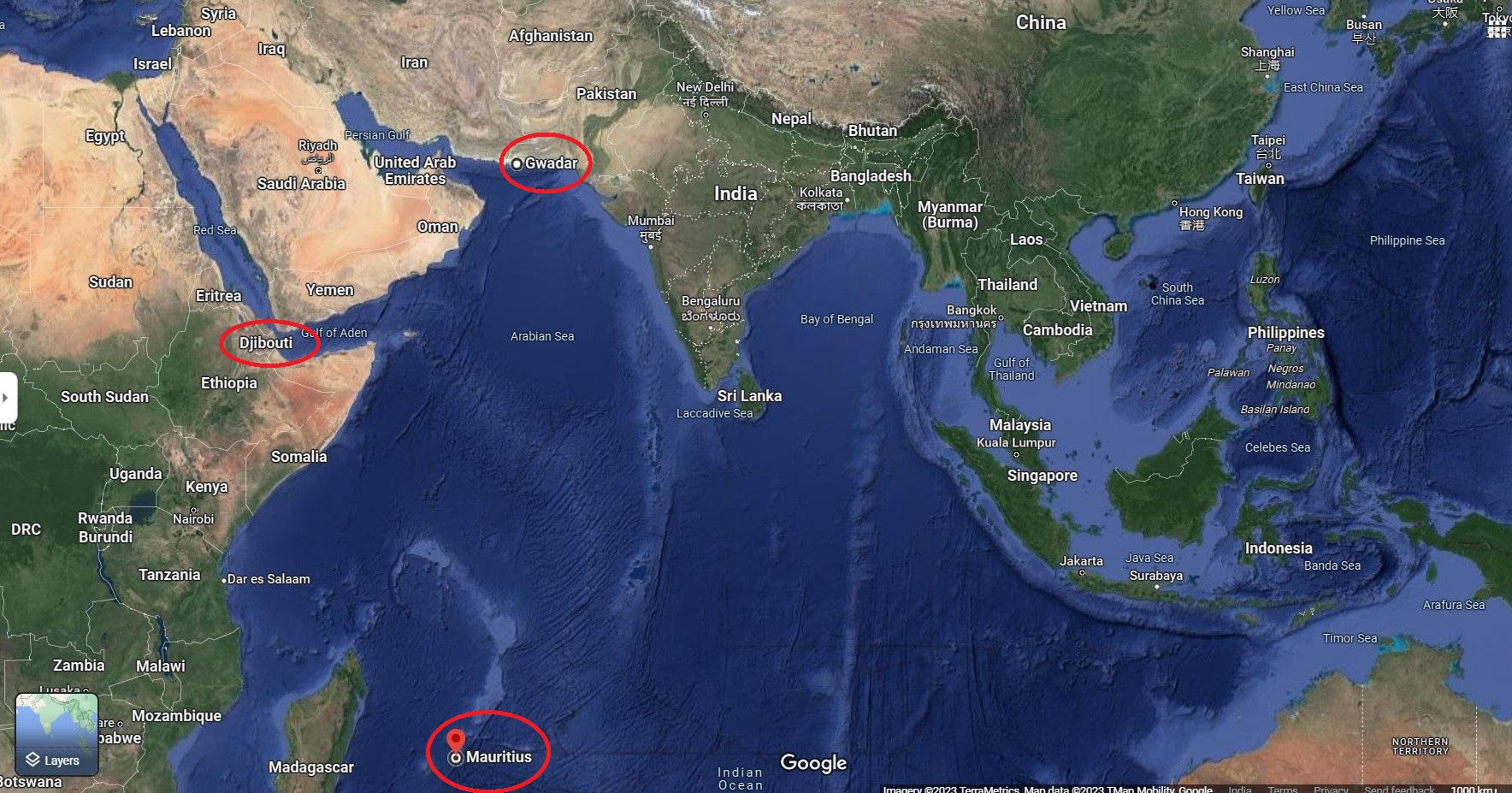Status quo in the Indian Ocean Region, dominated by anti-China-Pakistan groupings, is likely to see considerable change in the coming years.
The nearest Chinese naval base to India is located at Yulin naval base near the town of Sanya of Hainan province, a distance of roughly 3,500 km from India’s southernmost point as the crow flies in a straight line.
However, naval vessels don’t fly and hence, if today China has to bring its naval force into play in an assertive manner against India, its warships will have to take a long circuitous route to come near Indian shores,unless it already maintains a naval base or bases near India where its assets are berthed.
The People’s Liberation Army Navy (PLAN) has a fully functioning naval base at the African country of Djibouti; by multiple accounts, it is working to establish a similar naval station at Gwadar in Pakistan and it is eyeing a location in Mauritius where its naval ships can berth and keep an eye on the events on the Indian Ocean Region. Read and viewed separately, these existing and future Chinese naval bases don’t cause much concern. However, once they are seen in relation to each other, things change drastically.
As the picture of the Google map (shown circledin the map) that shows the location of these places, if China manages to build and operate its naval bases from all these three places in the future, then it will reach a position to control the entire Arabian Sea overlooking India’s western and southern borders and will be able to launch naval assertiveness exercise in the region in close coordination with its all-weather friend, Pakistan.
Once these naval bases come up, Indian assets will be under the direct sight of permanent Chinese naval platforms from three sides.One of the primary reasons for India’s win in the 1971 war with Pakistan was the successful execution of “Operation Trident” under which the Indian navy brought down Pakistan military might to its knees by attacking the Karachi port, the headquarters of Pakistan navy and its economic trade hub. This option of causing a naval blockade of Karachi is one of the effective deterrent that the Indian policy makers have against any Pakistani aggression in Kashmir.
This deterrent will, however, lose its potency if even one of the two Chinese naval bases—either at Gwadar or at one of the islands at Maldives—comes up.While India, due to its location and not-so-warm relationship with both China and Pakistan, will be the first in in line to face the threat emanating from these bases, the Western powers, including the United States, will too face the repercussions of the Chinese naval ships “patrolling” the region, an area of dominance that will cover the entire Gulf of Oman, Gulf of Aden and most of what lies in and around Mauritius.
As The Sunday Guardian had reported earlier (China looking for naval bases near Diego Garcia), the PLAN is actively scouting a place in Mauritius in lieu of the massive financial debt that the tiny country has to repay to a country that is likely to upstage the US as the global power of the world in the near time.
The understanding among the people concerned is that once China gets a suitable place in Mauritius, it will be able to build a base within 18 months. In the case of Djibouti, the construction by the Chinese engineers began in March 2016 and by 30 July 2017, the base had started functioning.
While the close military ties between Pakistan and China are well documented, the topic of their collaboration when it comes to the seas and oceans and the long term objectives of this collaboration has so far escaped closer scrutiny.China, as the action taken by it in the last few years shows, is focusing heavily on modernizing the Pakistan navy.
In 2017, China had handed over two maritime patrol vessels (MPVs) to the Pakistan navy that were to be based at Gwadar. Two more were later handed over to the Pakistan navy later. Given the security military ties between the two countries, it is estimated that more Chinese built military ships are now based at the Gwadar port.In January last year, Pakistan navy received PNS Tughril, one of the four frigates that it had ordered from China. This was followed by the arrival of PNS Taimur in August.
In 2016, Pakistan had announced that it was going to buy eight Yuan class submarines from China, the first four of which were to be delivered by the end of 2023 and the next four by 2028.In July 2022,the People’s Liberation Army (PLA) Navy and the Pakistan Navy (PN) held the “Sea Guardians-2” exercise in the waters off Shanghai in which the two focused on,among other things, neutralizing maritime security threats, securing strategic sea lanes, anti-submarine, anti-aircraft and anti-missile drills. This came after the first of such exercises, Sea Guardians-1, was held in January 2020 in the North Arabian Sea off Karachi, Pakistan.
The Gwadar port, which is under the total control of the Chinese officials, is located roughly 600 nautical miles from Strait of Hormuz, a waterway between the Gulf of Oman and the Persian Gulf through which about 25% of the world’s oil passes from source countries in the Middle East to foreign markets.
Official sources said in the coming five years, the Pakistan navy will have added three more advanced frigates, on the lines of PNS Tughril, all of which will be built and supplied by the Chinese.
China has also prevailed upon the Erdogan government in Turkey to help Pakistan add more teeth to its naval forces. Turkey has so far supplied three Corvettes to Pakistan in the last four years.The status quo in the Indian Ocean Region, dominated by anti-China-Pakistan groupings and relatively peaceful till now, is likely to witness a considerable change in the coming years.

